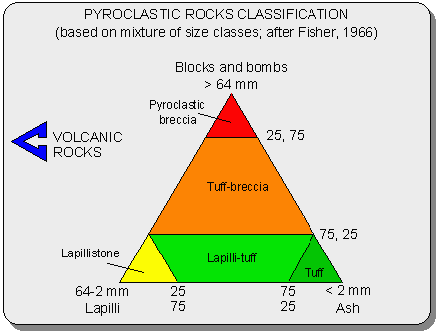
The solid Earth (the mantle and crust) is made of rock. You may have noticed that there are many kinds of rocks, from the soft sandy rocks that form the cliffs at Scripps beach to the hard rocks that form the mountains to the East of San Diego. Geologists have developed a way of classifying the various rocks and understand fairly well where they come from and where they go. There are three general types of rocks, those that form from melt (igneous rocks), those that are deposited from air or water (sedimentary rocks), and those that have formed by "cooking" or otherwise altering another rock (metamorphic rocks). Sedimentary rocks form by breaking down other kinds of rocks into small particles and washing or blowing them away; metamorphic rocks form from other rocks and igneous rocks form by melting other rocks. Thus rocks are always changing form and are redistributted as part of a giant cycle of renewal. This cycle is called the Rock Cycle.

When a partial melt forms, it rises and collects in a magma chamber (see Figure 3.2 in your book). In the magma chamber, the melt continues to crystallize thus changing its chemistry. This is a process known as magmatic differentiation. As magmas cool, different minerals will crystallize out of the melt. By studying the crystallization of melts in the laboratory, this process is fairly well understood. If these minerals settle out of the melt to the floor of the magma chamber, (see Figure 4.11 in your book), the chemistry of the remaining melt changes from a more mafic to a more felsic melt; thus, if fractional crystallization is taken to the extreme granite can be gotten from what was originally a basaltic melt.
The magma chamber may erupt from time to time. If the melt doesn't make it to the surface, it forms an intrusive rock. (see Figure 4.16 in book). Intrusive bodies can be big balloon shapes (plutons), sub-horizontal slabs (sills) or sub-vertical walls (dikes).
If it does make it, it becomes an extrusive rock. Extrusives can flow out over the ground (lava flows) or be blasted into the air to form ash falls and pyroclastics.
Igneous Rocks have a two-dimensional classification scheme based on chemistry, grain size and texture.
The key to chemical classification in igneous rocks is the amount of Silica (SiO2) in the magma. (Of course people who study this make a much bigger deal out of it! - see this web site). If magmas don't have much silica, their minerals are dominated by magnesium and iron (Fe) - hence the term MAFIC (MA- from the magnesium and FIC from the Fe), or even ULTRAMAFIC for the really silica poor varieties. Silica rich magmas have a mineral named feldspar in them (see book) and are called FELSIC as a result. You will also see the words "acidic" and "basic" used for felsic and mafic respectively and you should be aware that this has nothing to do with pH! One can often tell about how much silica is in a rock just by its color. The more silica, the lighter the color.
The main control of grain size is how fast the rock cooled from the molten state. Slow cooling allows bigger crystals to form, and fast cooling makes smaller crystals and even glass (no crystals). So the second dimension of igneous rock classification is whether the rock was formed by cooling on the surface as an extrusive rock. or in the crust as an intusive rock. Magma can either be erupted (extruded) as ash to make pyroclastic rock or as lava to make volcanic rocks.
| SiO2 (wt. %) | <45 | 45 -52 | 52 - 57 | 57 - 63 | 63 - 68 | >68 |
|---|---|---|---|---|---|---|
| Compositional or Chemical Equivalent | Ultrabasic | basic | basic to intermediate | intermediate | intermediate to acidic or silicic | acidic or silicic |
| Magma Type | ultramafic | mafic | mafic to intermediate | intermediate | intermediate to felsic | felsic |
| Extrusive Rock Name | komatiite | basalt | basaltic andesite | andesite | dacite | rhyolite |
| Intrusive Rock Name | peridotite | gabbro | diorite | diorite or quartz diorite | granodiorite | granite |
| Liquidus Temperature |  | |||||
| Mafic Mineral Content |  | |||||
| Water Content |  | |||||
| Mg/Fe |  | |||||
| Ca/Na or Ca/K |  | |||||
Igneous textures are classified by the presence or absence of crystals, the size of the crystals, and the size and density of vesicles (holes). Check out this page for a nice summary of igneous textures.
Pyroclastic rocks are classified by grain size from BOMBS (>64mm) to ash (<2mm). Lapilli are pea-like grains often in a finer matrix.
Here is a nice picture I found to illustrate the classification scheme of pyroclastics:

Volcanic rocks are mainly classified by the amount of silica. There are four main categories with increasing silica: basalt, andesite, dacite and rhyolite.
Intrusive rocks cool slower and have coarser grain sizes than their extrusive counterparts. The big four of intrusive rocks are with increasing silica: gabbro, diorite, granodiorite, and granite.
Lisa Tauxe